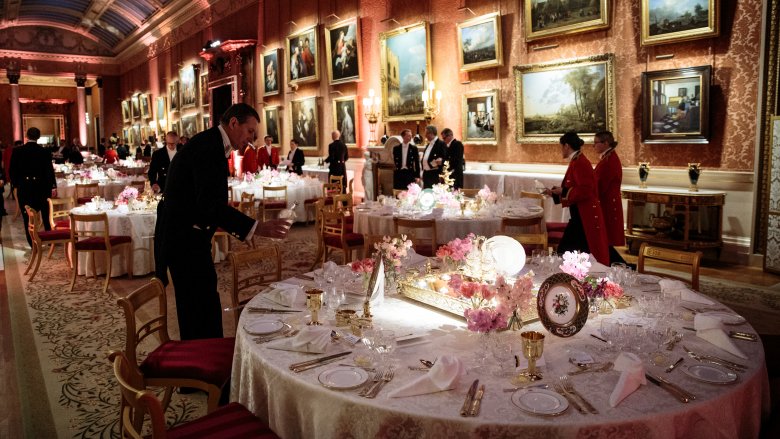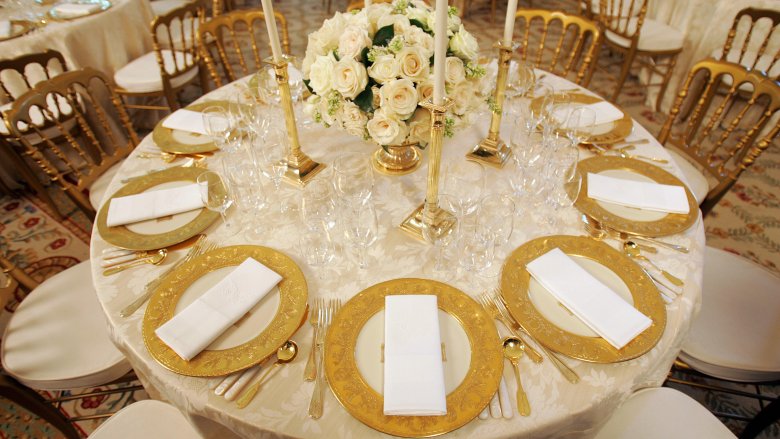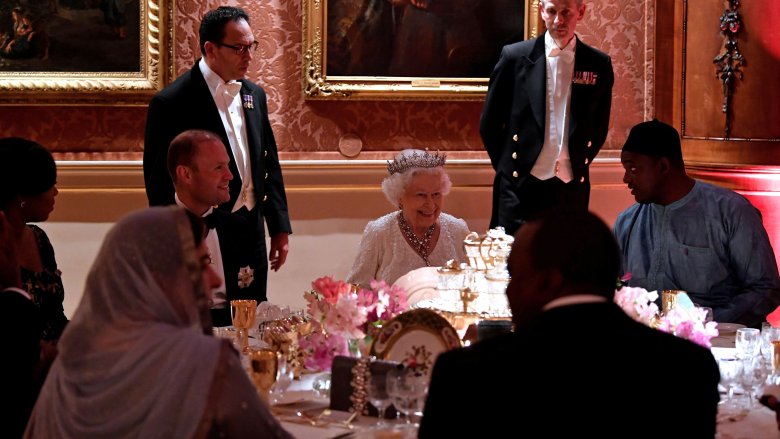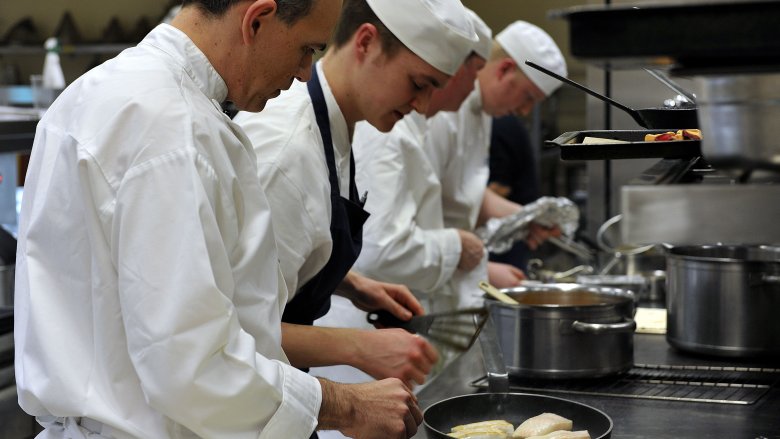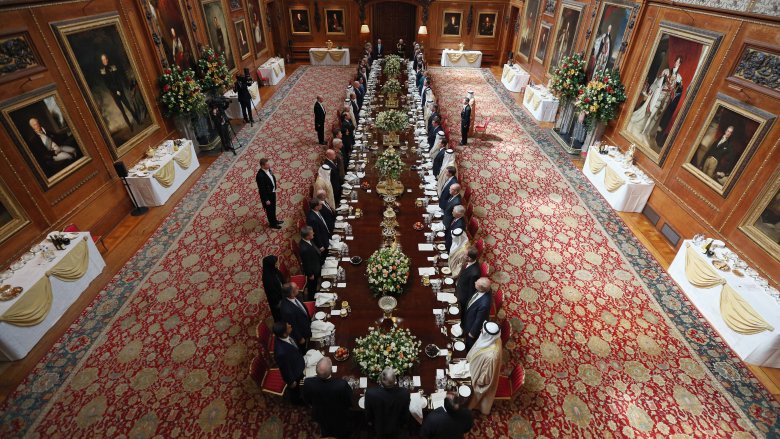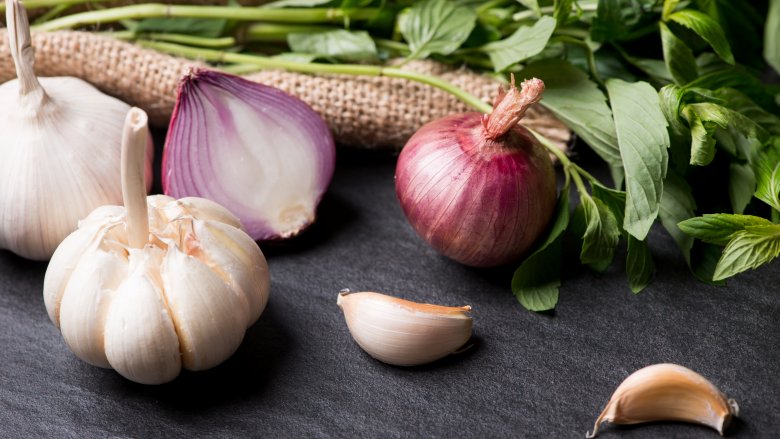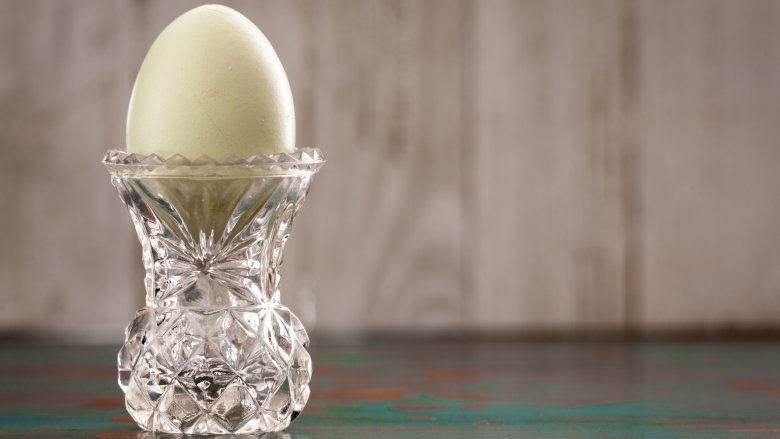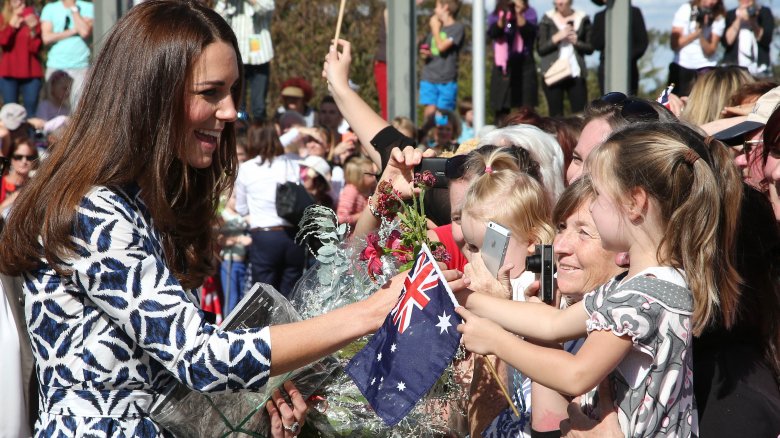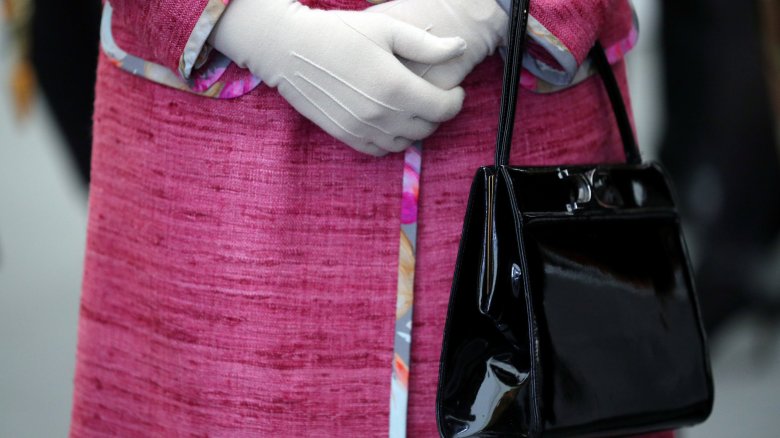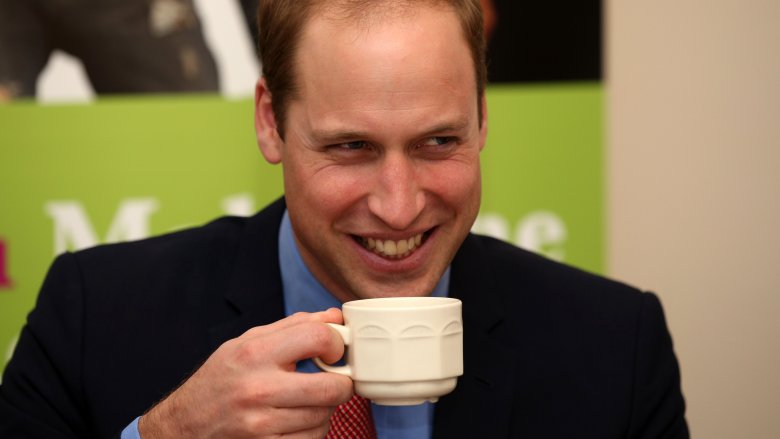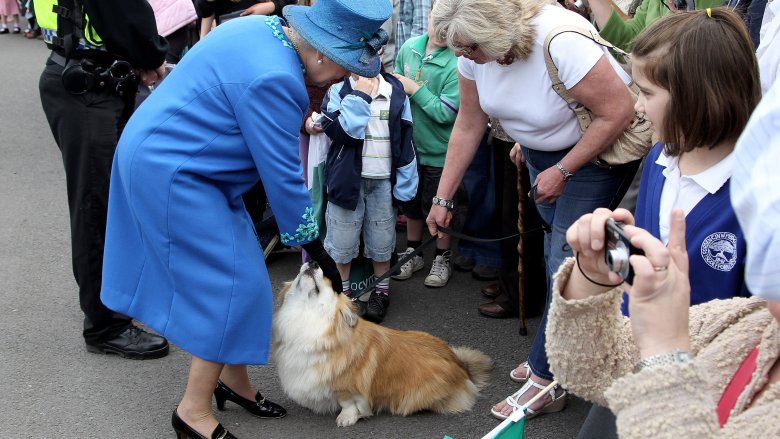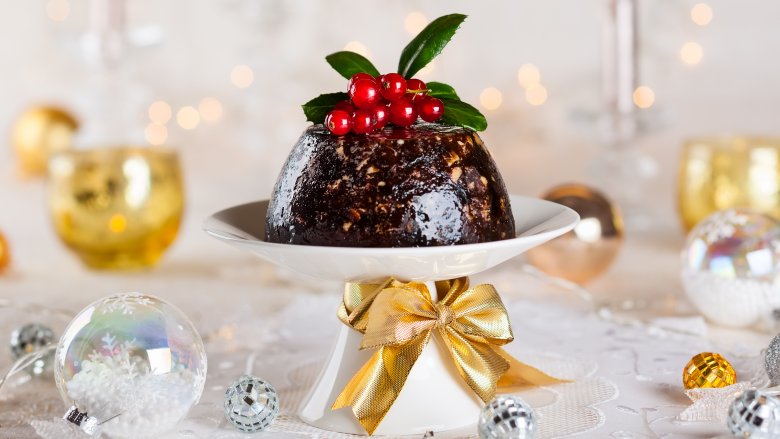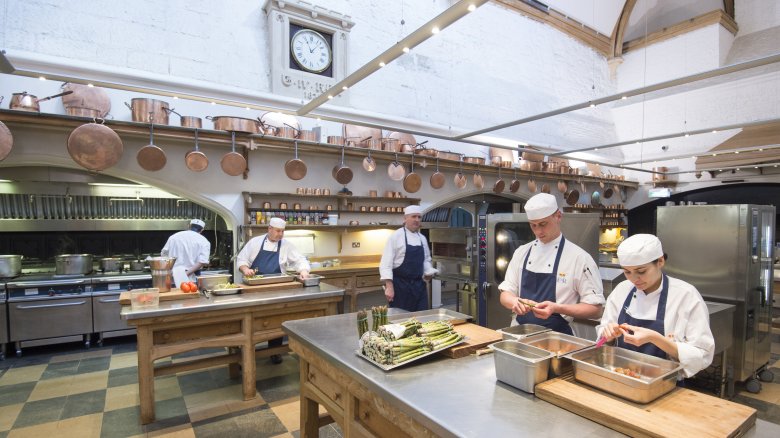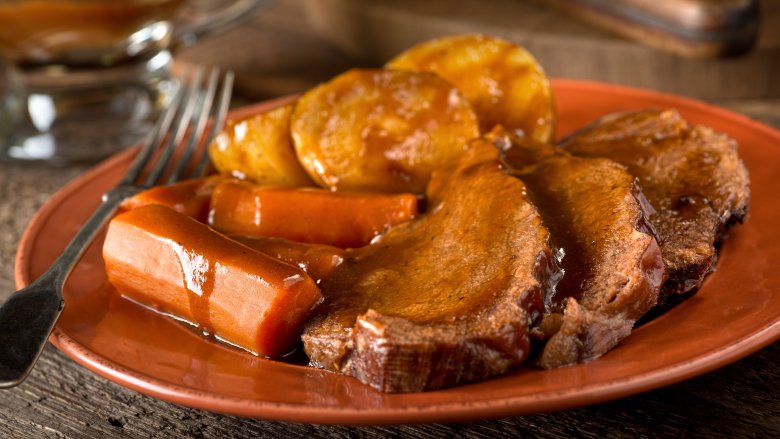Weird Rules The Royals Have About Food
It seems like being a prince or princess, duke or duchess, and even the king or queen of the British monarchy would have to be the easiest job ever. These titles once held some serious power, but they're mostly just figureheads today. You'd still get to travel the world, meet all kinds of people, see all kinds of sights, and — best of all — eat all kinds of amazing food.
But there's a catch, and that's the fact there are so, so many rules you need to remember to follow that it might just crush any bit of personality you might be tempted to show. Consider this: While not every dinner is a state function, those that are remain steeped in centuries' worth of tradition. The Telegraph says a state dinner takes an outstanding four months of planning and prep. With an entire staff spending days polishing the 5,500-odd silver pieces and 2,500-odd glass pieces that are going to be present on the table, it is any wonder they don't want anyone using the wrong fork?
It turns out, mealtimes are so complicated it's enough to make anyone grateful they're not a royal.
Utensil etiquette
Even if you know which fork is for your salad and which is for the main course, you're only a tiny fraction of the way through royal utensil etiquette. According to Business Insider, royals aren't even allowed to use forks like most of us do. There's no stabbing going on at a royal table, instead, diners hold forks in the left hand, knives in the right, and push food onto the back of the fork and eat from there. That takes some serious coordination — and it's the way the rest of the British population prefer to eat, as well.
There are rules about positioning utensils on the table, too. If a royal needs to excuse themselves, they're expected to do it quietly and discreetly. If they're not done eating, crossing their utensils is a sign they'll be back and they expect their plate to still be there. When they're done, that's when utensils are placed with the handles at the bottom right side of the plate, at an angle. This is actually the proper way for everyone to leave their utensils (though they may not know it), but it's definitely expected at royal functions.
The Queen sets the pace
Darren McGrady was Queen Elizabeth's personal chef for 11 years — that's a lot of meals served in royal settings. In 2014, he spoke with The Huffington Post about some of the stranger things he learned very, very quickly while working at Buckingham Palace. One was that it didn't matter how fast or slow anyone else ate, what mattered was when the Queen was done.
"As soon as she put down her knife and fork from the first course, he [the Palace steward] would hit the button for the lights to signal the footmen to come in. The course was over and they'd start clearing — even if you hadn't finished, they'd be clearing the table."
So, eat up and eat quickly, before your plate gets swept away with a half-finished meal still on it. At least, that's the rule during formal banquets, and let's be honest — those are the times you know everyone is watching everyone else and keeping track of every faux pas that's made.
Stop cooking
Anyone who has ever worked in or seen a professional kitchen knows just how chaotic it can get. Normal restaurants the poor commoners frequent are busy enough, so just imagine how busy a kitchen is when they're trying to prepare a state dinner. There are dozens and dozens of high-profile guests, multiple courses, and, says The Telegraph, a minimum of five different wines. Every minute counts when chefs are trying to get all that prepped, cooked, plated, and served, but when the Queen sets foot in the kitchen to see what's going on, everything must stop.
Everything.
According to what Queen Elizabeth's former personal chef Darren McGrady told The Huffington Post in 2014, it didn't matter what sort of time-sensitive dish you were working on when the Queen came in. All pans were moved to the side of the stove, the chefs needed to take three steps back, and were expected to bow to the monarch before answering any questions she might have. Something's burning in the oven? Something's about to get ruined? It doesn't matter, and it's only after she leaves that cooking can resume.
Mealtime conversation flow
When Formula 1 driver Lewis Hamilton received his MBE from the Queen, the honor came with a meal at Buckingham Palace. According to The Telegraph, it was during the meal that he was scolded for not following the rules, and he learned a very important lesson about the art of conversation at the dinner table of the British royals.
What he didn't know is there's a strict rule about how conversation starts, continues, and ends. Etiquette experts say the women at the table start the meal by striking up a conversation with the person to their right. In the case of the Queen, the person on her right is considered the guest of honor. (Hamilton was seated on her left.) It's only when the meal reaches the halfway point that the Queen — followed by the other women at the table — turns to talk to the person on the left. One thing's for sure: everyone better be on their A-game and ready to button up some conversations quickly before the switch.
Garlic and onions are out
Imagine a world without garlic and onions, and you're imagining a world most people wouldn't want to live in. But that's exactly the kind of world the royals do live in.
There are a few different reasons given for the off-limits nature of garlic and onions, and according to what Camilla Parker-Bowles said on an episode of MasterChef Australia (via Newsweek), the reasoning is partly a hygienic one. Part of being a royal is the non-stop polite conversation, and garlic-breath doesn't make the best impression.
It's said that the Queen's personal dislike of garlic has something to do with the ban as well, but there's a bit of good news. The Daily Express says the no garlic, no onion rule only applies to ultra-formal settings like state banquets, but if you're dining with the Queen even casually, it's probably still off-limits. Former Buckingham Palace chef adds, "We can never serve anything with garlic or too much onions. The Queen would never have garlic on the menu."
There are a lot of eggs on the table
There's a rumor that Prince Charles is so particular about his eggs that he has the kitchen prepare seven different eggs for him every morning, and he chooses the one that's most acceptable. The Telegraph says it's a myth, and the royals have gone out of their way to deny there's any truth to this bit of gossip.
Myth status of this one aside, the royals do like their eggs. According to Prince Charles's former chef Mervyn Wycherley (via The Guardian), there was one simple and unbreakable rule for preparing his eggs: they needed to be boiled for exactly four minutes. Eggs are served with every royal breakfast and for tea, but it's usually brown eggs for the Queen. She says they taste better, and this royal obsession with eggs is one that goes back at least to Queen Victoria. She used to eat her boiled egg from a gold cup with a gold spoon, which is possibly the fanciest way to eat such a normal food.
Sometimes they can accept food gifts, sometimes not
There are a ton of rules dictating what gifts members of the royal family can accept, what they can't accept, and what needs to be donated to charity. According to royal protocol, those rules extend to food, as well.
They say the royal family is only allowed to accept gifts from private residents that have a value of less than £150, which is around $190 USD. Instead, they encourage gifts like food, flowers, and books — as long as it's a reasonable quantity (so make enough cookies for the Duke and Duchess, but not enough to serve at a state dinner). Also, those rules don't say they have to eat it, so unless you think the Queen is likely to nosh on bakes goods from an unknown kitchen, maybe don't waste your time.
The Queen's purse can end a meal
The Queen is always well- and brightly-dressed, and she's almost never seen without her handbag. A royal biographer (via The Telegraph) once got a peek at what's inside (and it's things like a mirror, lipstick, and a donation ready for the church), but it's not what's inside that's really interesting.
There are a ton of signals the Queen's entourage is constantly on the lookout for, and many of them have to do with the positioning of her handbag. When it comes to mealtimes, it's often hung from the underside of the table on a convenient hook she carries just for that purpose. (One dinner guest was reportedly shocked to see the Queen spitting on a plastic suction cup and affixing it to the underside of the table before hanging up her purse.)
But when she removes it from the hook and places it on the table, everyone kicks into high gear. That's a sign she wants the entire meal to come to an end within the next five minutes, and what the Queen wants, the Queen gets.
There's lots of tea rules
Tea is a big deal for the royal family, and there are some surprising rules that go along with making and serving it properly. Seems like too much effort? Afternoon tea traditions are old ones, dating back to 1662.
Grant Harrold is a former royal butler, and he's revealed (via Business Insider) exactly what the right way to make tea is... if you're making it for the royals, at least. The tea goes into the cup first, then the milk is added, and when you're stirring, you should be stirring with a back-and-forth motion while never, ever touching the sides. (That's a practical rule that dates back to a time when tea cups were extremely fragile, and the slightest touch could crack them.)
There are rules that need to be followed when you're drinking that tea, too. Royals are taught to hold the top of the cup's handle between the thumb and forefinger, and to use the middle finger to support the bottom. Contrary to popular belief, the pinkie should never, ever be held out, and much to the delight of anyone suffering from misophonia, slurping or making any sound when putting the cup in its saucer is absolutely out.
The Queen's corgis had their own set of food rules
The Queen's love for corgis is notorious, but less well-known is that most of them were descended from a single corgi named Susan. She was given Susan as a present for her 18th birthday, and when the last of Susan's line — the 14th generation Willow — died in 2018, she marked the end of an era (via Smithsonian). The queen stopped breeding them because she didn't want any to outlive her, and that's true love. She loved the dogs so much that there was a series of rules put in place for their meals, too.
Former chef Darren McGrady talked to HELLO! about the dogs' special menu, and said their menu was designed by their Sandringham keeper, Mrs. Fennick. They would be served an alternating menu of beef, chicken, lamb, and rabbit, poached and chopped to make sure there were no bones. Some days rice or cabbage would be added, and sometimes, they were served the rabbits brought back from William and Harry's hunting expeditions out onto the estate. The Queen — who traditionally kept about 12 dogs — would even feed them herself, after her tea.
This food is always given as a gift at Christmas
Not surprisingly, there are a ton of old traditions that are still followed in the royal family, and one of those includes giving Christmas gifts to staff.
Harper's Bazaar says this long-running, food-related Christmas tradition dates back to Queen Elizabeth's grandfather, George V. He was the one who first gave royal staffers a Christmas pudding for the holidays, and it's a gift-giving tradition that continues... albeit in a slightly modified form.
Between palace staff, employees at the Court Post Office, and Palace Police, the royals give out about 1,500 puddings every December. For a long time, the puddings were sourced from Fortnum & Mason, the royal grocer. In more recent years, the royals have started shopping at Tesco. For our American friends, that's sort of like giving everyone a fruitcake (but one that you actually want to eat) you bought at Wegmans. Some staff — like long-time employees and some staffers stationed at Buckingham Palace and Windsor Castle — get something a little extra, but Christmas puddings? It might not sound like much, but they're actually pretty delicious.
Waste not, want not
When the royal family isn't visiting abroad or hosting massive state dinners, some of the rules are a little different. When former chef Darren McGrady shared (via the Vancouver Sun) what it was really like behind the scenes at the royals' more private meals (like some prepared at Windsor's kitchen, pictured here), he also shared something pretty surprising: they're actually quite frugal.
While the Queen gave only the best to her dogs and horses, she scrimped when it came to her own meals — something McGrady says she likely learned from living through World War II. Her frugal nature was so extreme at times that she would squeeze a bit of lemon juice on a dish, then send the lemon back to the kitchen to be saved for the next time.
Another former chef, Carolyn Robb, told Racked that when left to plan their own meals, Charles and Diana had very strict rules about how nothing was allowed to go to waste. Tupperware was a staple kitchen item, because one night's roast was the next night's shepherd's pie.
That's a pass on the caviar
If you expect royal dinners to be all caviar and steaks, you might be surprised to find that's not always the case. Former chef Carolyn Robb talked to Racked about just what got served up to royals like Charles, Diana, William, and Harry when it was time for just small, private meals, and it was hearty food that's familiar to everyone. They preferred game they killed themselves in hunts during the day, vegetables from their gardens, and wild mushrooms gathered from the property. When it came to what they actually wanted to eat, it was small portions of hearty meals, and best of all? There were no fancy dinner settings.
Robb says when they were out of the public eye, it was roast chicken and fish fingers for the boys, who sometimes pushed their way into the kitchen themselves to whip up some spaghetti bolognese. And when it was just the family, meals were often on trays in front of the fire, with presumably no rules about which forks were off-limits.
